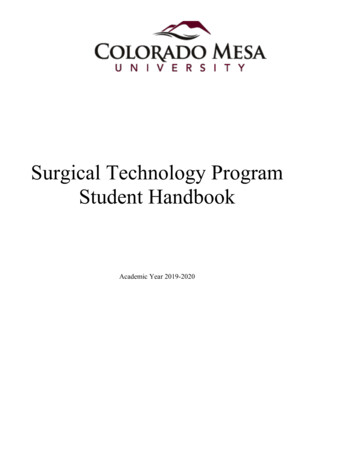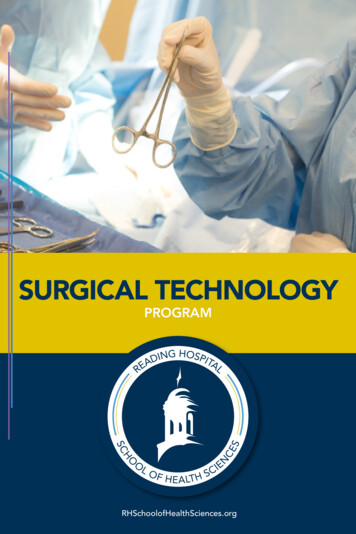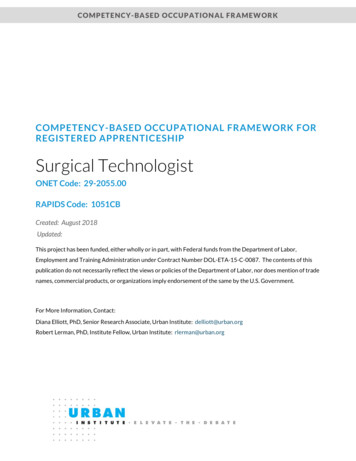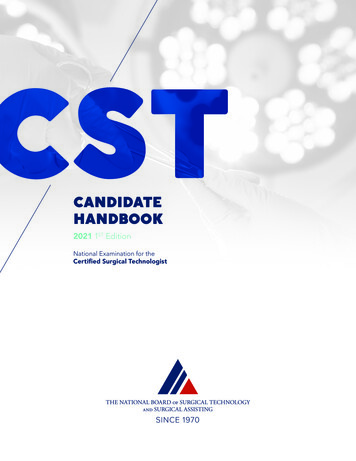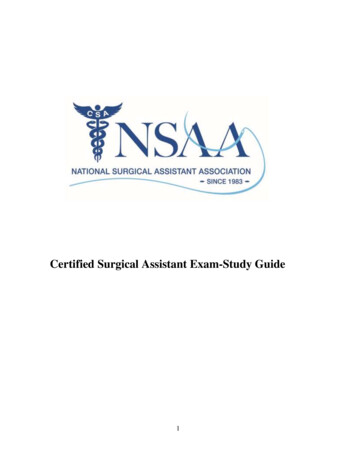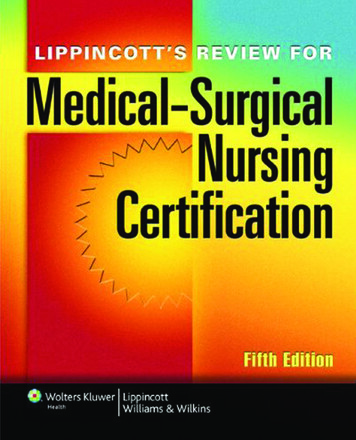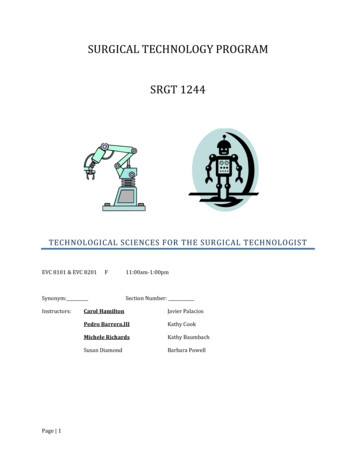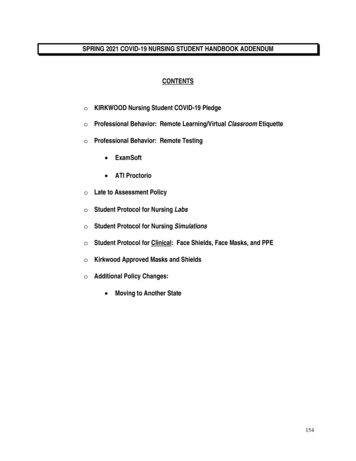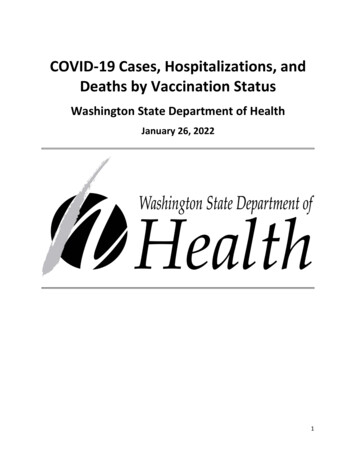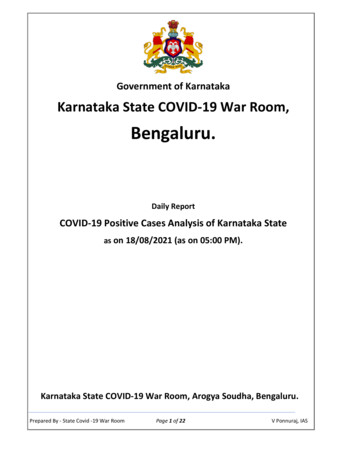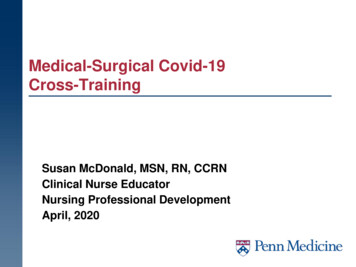
Transcription
Medical-Surgical Covid-19Cross-TrainingSusan McDonald, MSN, RN, CCRNClinical Nurse EducatorNursing Professional DevelopmentApril, 2020
COVID-19 There is a website on the Penn homepage with informationregarding Covid-19 that is updated daily Check the website for the most recent information ss/coronavirus Covid Tip sheets Epic banner2
COVID-19 Most commonsymptoms includescough, fever andshortness of breath May appear 2-14 daysafter exposure Ranges from mild tosevere respiratoryillness3
PPE4
Communication Most floors have a daily huddle at change of shift and it is theexpectation that you attend Documentation should be done in real time (vital signs, etc.) Each floor has specific patient populations and protocols Please check with the charge RN and/or CNS/CNE foradditional resources Throughout your shift please keep the lines of communicationopen with primary RN, charge nurse and CNS/CNE whenapplicable Do not be afraid to speak up if you are hesitant or unsureabout something We want you to feel safe, comfortable and supported!5
Resources Navigating to Elsevier Video Resources- PPMC Intranet- Right handside- Elsevier Clinical Skills6
Various Tiers explained: Tier I- Primary Nurse (may be the primary nurse caring for amodified assignment) Tier II- Support the primary RN- completes task as delegatedby the primary RN Tier III- Functions similarly to a CNA to support the primary RN7
Alert BandsDNR bracelets arePURPLE8
Clinical Alarms Alarm volumes should be set at a level so that staff can hearthem Anytime you hear an alarm you should go to room to assessthe patient Alert the primary RN to the situation9
Head to Toe Assessment Neuro- AAOx, pupils Cardiac- Listen to the heart sounds, assess rate & rhythm,asses distal pulses and assess for edema Respiratory- Listen to the lung sounds anteriorly &posteriorly, take note of diminished lung sounds, crackles,wheezes, etc. Note SOB GI- Inspect the abdomen, auscultate and palpate. Ask aboutlast bowel movement and N/V. Check diet order. GU- Quality and quantity of output, how are they voiding, anyPO intake restrictions, dialysis Skin- Assess for wound breakdown (especially bonyprominences) and incisions. Assess drains and quality andquantity of drainage output. Note IV access and check forpatency.10
Accu-Chek Testing Operator ID is your Penn ID number Patient ID is CSN # CSN # scan Number is located below Patient’s name onwristband Only scan the patient’s wristband- never scan alabel that is not attached to the patient11
Accu-Chek Testing Meter reading range:10-600 mg/dL “LO” or “HI” if outside range – also possible with an operatorerror A serum glucose specimen MUST be sent to the Lab for a “LO”or “HI” Critical patient values:less than 40 and greater than 500 MUST be reported to RN/MD immediately Recommended to send a serum glucose specimen to Lab12
Accu-Chek Testing Base Unit Return the meter in base unit after testing Recharges battery & automatically uploads the result to Epic Wipe away 1st drop of blood – with GAUZE (not alcohol prep) 1st drop contains interstitial fluid 1st drop may contain alcohol (from cleaning) Helps more blood to flow13
Accu-Chek Testing When to repeat a test on the meter: If the Patient’s appearance does not correspond to the result If you didn’t apply enough blood to the strip When to send a serum glucose specimen to the Lab: “Lo” or “Hi” result Decreased peripheral blood flow Anytime the result is in question14
Accu-Chek Testing Cleaning / Disinfecting the meter Must be done after every patient test Use Clorox Bleach wipes OR facility-specific approved wipes– Allow to dry for recommended contact time per manufacturer’slabeling– Be careful – do NOT get solution inside of meter (stay away fromopenings on meter)15
Head to Toe Assessment Neuro- AAOx, pupils Cardiac- Listen to the heart sounds, assess rate & rhythm,asses distal pulses and assess for edema Respiratory- Listen to the lung sounds anteriorly &posteriorly, take note of diminished lung sounds, crackles,wheezes, etc. Note SOB GI- Inspect the abdomen, auscultate and palpate. Ask aboutlast bowel movement and N/V. Check diet order. GU- Quality and quantity of output, how are they voiding, anyPO intake restrictions, dialysis Skin- Assess for wound breakdown (especially bonyprominences) and incisions. Assess drains and quality andquantity of drainage output. Note IV access and check forpatency.16
Chlorhexidine (CHG) Bathing Bathing should be done daily for patients with a central line Can also be done pre-operatively before certain surgical orinvasive procedures CHG solutions should only be applied from the chin down Apply CHG solution directly to the wet skin for all areas,except the face, eyes, ears, mouth and genital area Refer to specific unit practices17
Oral Hygiene & Denture Care Hand hygiene Set up supplies Have patient to brush teeth or assist patientwith brushing Allow patient to floss unlesscontraindicated Have patient rinse thoroughly-emesis basin Determine if patient can clean denturesindependently or needs assistance Instruct patient to remove dentures orprovide assistance in removing them Adhesive seal to place dentures back in orsoak in denture cup of warm water ORAL CARE AM AND PM ANDEVERY 4 HOURS IF NPO!18
Feeding Assistance for Oral Nutrition Perform hand hygiene Determine readiness and ability to eat independently If patient is at risk for compromised swallowing, raise HOBand have suction readily available Obtain any assistive devices the patient may need Assist the patient to perform hand hygiene. Ensure that meal tray is complete and correct Assist a patient who cannot eat independently Check orders for special diet or fluid restrictions19
Code Status in Penn ChartClick formore detailsFull CodeMay intubate,do notresuscitateDocumentgoals of care inAdvance CarePlanning (ACP)NoteDo notintubate, donot resuscitate Complete all resuscitation efforts Chest compressions, intubation Patient may be intubated, but does notwant compressions Treatment limitations and goals of carediscussion in Advance Care Planning Note No ACLS*In the event of an emergency, “Not on file” and “Prior” should be treated as full code20
Clinical Emergencies:Rapid Response/Code Call Code CallRapid ResponseFalls ResponseStroke AlertAirway EmergencyAnesthesia STAT Give location21
Criteria for Initiating RRT Chest Pain– HR 140, 40– BP 200 systolic, 100 diastolic; 80 diastolic with symptoms Respiratory Problems––––Rate 35, 8Difficulty breathing/Dyspnea (new onset)Pulse ox 85%Increased oxygen requirements–––––Acute loss of Consciousness / SyncopeSeizureNew onset of lethargy/difficulty wakingSudden loss of movement / weakness of face, arm, legNew difficulty speaking––––Fall with injury or change in neurological statusUnexplained agitation, confusion or deliriumLoss of pulsesUncontrolled bleeding Neurologic Problems Other problemsANYTIME the nurse is concerned about the patient!22
Aspiration Risk Tool (ART screen)23
Telemetry Lead Placement Prior to placing the monitor on the patient ensure that is theright patient, right monitor, and right room number Apply ECG electrodes to pre-selected and prepared skin sites Clip hair in a 2x2 inch square for each electrode, if appropriate Cleanse areas with soap and water, dry with towel whileabrading the skin lightly. Clean areas with alcohol only ifextremely oily We can also prep with skin prep24
EKG- What are indications?EKG video25
Tracheostomy Suctioning Connect one end of the connecting tubing to the suction canisterTurn the suction device on and adjust the vacuum regulator to less than 150 mm HgPrepare the disposable suction catheter.Using aseptic technique, open the sterile catheter package on a clean surface, using theinside of the wrapping as a sterile field; open the package just enough to expose theconnecting end and connect the catheter to the suction tubing.Unwrap or open the sterile basin and place it on the bedside table. Be careful not to touchthe inside of the basin. Fill the basin with sterile 0.9% sodium chloride solution or sterilewater.Remove gloves, perform hand hygiene, and don sterile gloves.Connect the suction catheter to the connecting tubing.With the dominant hand, pick up the suction catheter, taking care to avoid touching anynonsterile surfaces.Wrap the suction catheter around the sterile dominant hand to help prevent inadvertentcontamination of the catheter.With the nondominant hand, pick up the connecting tubing and connect it to the suctioncatheter.26
Tracheostomy Suctioning Check the equipment for proper functioning by suctioning a small amount of sterilesolution from the container. With the dominant hand, gently but quickly insert the catheter into the tracheostomy tubewith the control vent of the suction catheter open. Do not apply suction during insertion. In a patient at high risk for suction-related complications, insert the catheter into thetracheostomy tube until it emerges out of the end of the airway. In a patient not at risk for suction-related complications, insert the catheter into thetracheostomy tube until resistance is met and then pull back 1 to 2 cm. Using the nondominant thumb, depress the control vent of the suction catheter to applycontinuous suction while completely withdrawing the catheter. Ensure that each suctionpass does not last longer than 15 seconds to minimize decreases in oxygen saturation.Do not instill 0.9% sodium chloride solution before suctioning. Perform one additional pass of the suction catheter if secretions remain in the airway andthe patient is tolerating the procedure. Allow a minimum of 20 to 30 seconds betweenpasses for the patient to recover before the next pass. Consider administering 100% oxygen to the patient between each pass of the suctioncatheter. At the completion of the suctioning procedure, consider administering 100%oxygen for 30 seconds. Return supplemental oxygen to the baseline level. Assess the volume, consistency, and color of the airway secretions. Notify thepractitioner of changes in the airway secretions Trach Suctioning27
Chest Tube Management Indications: pneumothorax, hemothorax, tension, pleuraleffusion, s/p cardiac or thoracic surgery Monitor for s/s of respiratory distress Encourage the patient to cough and deep breathe Monitor for subcutaneous emphysema and air leak every shiftor as needed Assist patient with Incentive Spirometry per order Activity as allowed (should not disconnect from suctionwithout a physician’s order, use portable suction machines) Chest percussive therapy (PT) if appropriate as ordered Dressing changes QD28
Enteral Nutrition Verify patient name, MRN, formula type, as well as expirationdate, route and rate of delivery Keep head of bed 30 degrees or greater, unless contradicted Deliver via pumpDobbhoff (Feeding Tube)Percutaneous EndoscopicGastrostomy Tube (PEG)29
Ostomy Care Perform hand hygiene and don clean gloves Explain the procedure to the patient, remove presentappliance and discard Clean skin and stoma with warm water (no soap is required) Remove gloves, perform hand hygiene and don new cleangloves Inspect stoma and peristomal skin (skin should be red/pinkand moist) Measure stoma using stoma guide Select and prepare new appliance and cut to proper size Remove paper backing from the wafer, apply a small bead ofstoma paste to the wafer directing next to the hole that wascut (this will help prevent leaks) Roll up bottom of drainable pouch and check seal Remove gloves and perform hand hygiene Ostomy Care30
Care of Surgical Drains Types of Drains- The most common drains on the floors are JPdrains and Hemovac drains Start with putting on appropriate PPE, remove old dressings whileassessing the drain site and quality and quantity of output. Emptythe drain and record output in the I and O flowsheet in Epic m/skills/414/videos?skillId GN 37 3#scrollToTop31
Pain Management Orders: Scope of Practice Contact provider if PRN orderdoes not support patientreported level of pain Practice The 5 Rights ofMedication Administration32
Pain Assessment and Reassessment Patient reporting pain requirean individualized care plan Complete a comprehensivepain assessment on patientswho report pain on admissionor have pre-existing pain priorto admission33
Transfusions Prior to picking up the blood product for transfusion verify thatthere is consent in the medical record or paper chart for thisadmission If asked to pick up a product from the blood bank, please handthe product to the nurse upon arrival The transfusion should be started within 30 minutes frompicking the product up from the blood bank Follow policy regarding strict 2 RN administration Prior to administering a blood transfusion, check & documentbaseline vital signs Stay with the patient for the first 15 minutes of transfusion anddocument vitals again after 15 minutes, at one hour and everyhour during transfusion, as well as at completion oftransfusion Possible reactions- fever/chills, changes in BP and HR, pruritis& hives, SOB, pain (All transfusion reactions should beconsidered as potentially serious)34
High Alert Medications All patients must have the LGH ID band and should beidentified using 2 patient identifiers before ANY medicationadministration A high alert medication, or HAM, is a medication that carries aheightened risk of causing significant harm if it is used inerror. Medications classified as HAMs have a narrowtherapeutic index. Drugs with a narrow therapeutic index aredangerous because small changes in dosage or blood druglevels can lead to dose- or blood concentration-dependentcritical events. With HAMs, adverse events are persistent, lifethreatening, permanent, and can lead to disability, the need forhospitalization, or death.35
High Alert Medications All anticoagulants are HAMs because the high incidence ofsevere and fatal bleeding events in patients on thesemedications. If the wrong type of anticoagulant or wrong doseis given, the inability of the blood to clot can be devastating Unfractionated heparin (UFH) is associated with a high rateof drug-related problems due to either its inherentpharmacologic properties or an extension of these propertiesoften caused by medication errors. Unfractionated heparin has been classified as a high-alertdrug by the Institute for Safe Medication Practices.36
High Alert Medications Insulin comes in several different preparations, each of whichworks slightly differently: some last up to a whole day (longacting), some last up to eight hours (short-acting) and somework quickly but don't last very long (rapid-acting) If the wrong kind or amount of insulin is given at the wrongtime, their blood sugar can drop to low levels that could resultin altered mental status, seizure, coma, or death37
Admission- Suicide Assessment38
Environmental Safety Check- Suicide Flow sheet Environmental Checks Occur with EVERY change of caregiver String less 3 hole gown, jumpsuit, sweat suit (lock away clothes, belts,shoelaces, etc.) Knives, razors, scissors removed Glassware removed (including mirrors) Medication and toxic substances locked away No matches or lighters Ligature risks removed No silverware (plastic tray and plastic ware for meals) Belongings brought in cleared by RN Patient observed for signs of injury or hidden objects Lift device disabled and lift sling removed Mitigation39
What is a ligature? “A ligature risk is defined as anything which could be used to attach a cord, rope,or other material for the purpose of hanging or strangulation.” – CMS ManualSystem, Transmittal 176 Examples: Hand rails Door knobs Door hinges Shower curtains Exposed plumbing/pipes Soap and paper towel dispensers on the wall Power cords Call bell cords Light fixtures or projections from the ceiling Remove any ligature risks that you are able to and be aware of those that cannotbe removed40
Ligature Risks41
Documentation Safety Observation Flow sheet Initiation & Change of observers Behaviors Observed Q2 hrs & PRN RN Assessment All ‘Patient and Family Education’ Once a shift & PRNOutlined in PolicyAdd “Potential for Suicide’ problemto plan of care42
Restraints: What is it? Definition Any manual method, physical or mechanical device, material, orequipment that immobilizes or reduces the ability of the patient tomove his or her arms, legs, body or head freely Unnecessary restraint is false imprisonmentFor further information, see policy 11.134 Management ofRestraints and Seclusion (Violent & Non-violent Behavior)43
Mitts Typically used to restrain behaviorthat would interrupt medical/surgicalcare Any use of the mitt is a restraint, notjust if it’s secured44
Soft Limb Restraints Can be used on one to all four limbs Secure to non-movable part of the bed with quick-release buckles or ties45
Neoprene Restraints Posey Quick-Release Will be stocked in each unit Ankle (red) and wrist (blue)restraints secure with extra-longhook and loop and quick-releasebuckles Can be used for violent or non-violentrestraint order Can be used for patients who are toobig or strong for the soft limb restraints Neoprene cuffs gentle on patient’s skin46
Changing log in ContextSystem lists LGH Units Choose the floor you areworking on47
BCMA/Rover All medications administered on units utilizing barcodemedication administration (BCMA) must follow scanningprocedures at time of administration or bag hang Barcoding does not replace any of the other steps ofmedication administration safety described Knowledge link modules available Rover is an application on the I-phone for barcoding48
Various Tiers explained: Tier I- Primary Nurse (may be the primary nurse caring for amodified assignment) Tier II- Support the primary RN- completes task as delegatedby the primary RN Tier III- Functions similarly to a CNA to support the primary RN49
5 Communication Most floors have a daily huddle at change of shift and it is the expectation that you attend Documentation should be done in real time (vital signs, etc.) Each floor has specific patient populations and protocols Please check with the charge RN and/or CNS/CNE for additional resources Thr
